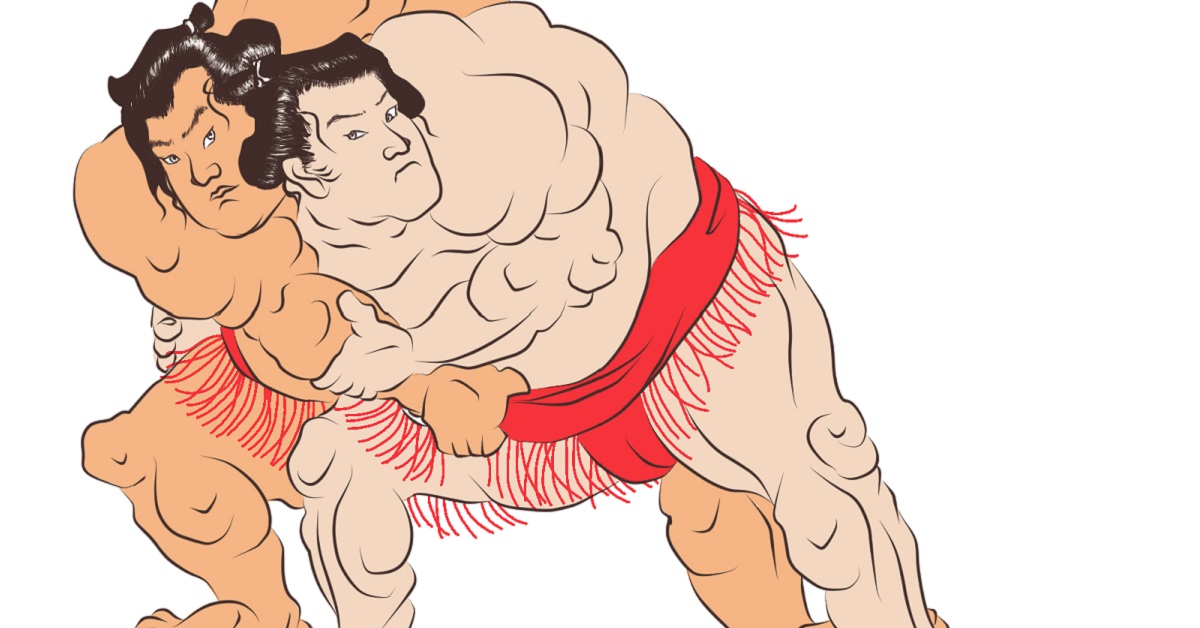In sumo, harite is not just a slap—it is a tactical strike using the heel of the palm to unbalance the opponent and seize control. The loud crack of contact and the visible shock it delivers make it one of the most dramatic techniques for spectators. Understanding harite helps beginners and foreign fans see sumo as more than a contest of size, but a battle of skill and strategy.
The Basics of Harite
Harite is categorized as part of sumo’s pushing and thrusting techniques. The wrestler swings his open hand and drives it into the opponent’s face or the side of the neck. Because it uses the heel of the palm (shotei), the strike delivers far greater impact than it may appear, often causing the opponent’s head to snap back or their stance to collapse. The aim is not merely to cause pain but to disrupt the opponent’s balance, blind their line of sight, and create openings for further attacks. Push-and-thrust specialists often employ harite in succession to drive their opponent back to the tawara (edge of the ring). For the audience, the sharp crack that echoes across the arena is both impressive and thrilling, embodying the raw power of sumo.
Harite vs. an Ordinary Slap
At first glance, harite resembles an ordinary slap, but the two are fundamentally different. A slap in daily life relies mostly on wrist snap and the flat palm, whereas harite harnesses the entire arm, driving the heel of the palm into the opponent to deliver a deep shock. While slaps are often used as emotional gestures, harite serves a tactical purpose: to destabilize the opponent and gain control of the bout.
| Aspect | Harite | Ordinary Slap |
|---|---|---|
| Main striking area | Heel of the palm and full hand | Palm surface |
| Purpose | Break opponent’s stance, seize advantage | Expression of anger, punishment |
| Force | Strong | Moderate |
| Context | Part of sumo’s techniques | Everyday act |
Understanding this distinction helps audiences avoid dismissing harite as “just slapping” and instead recognize it as a deliberate combat strategy.
When Harite is Used and Its Tactical Value
Harite is not a universal move but is used strategically in specific situations. At the tachiai (initial clash), a wrestler may strike to disrupt the opponent’s focus or raise their center of gravity. This split-second opening can determine the course of the match. During pushing contests, multiple harite can drive the opponent backward to the edge. Used defensively, harite can also blunt an opponent’s forward momentum and set up counterattacks.
| Situation | Purpose of Harite | If Successful |
|---|---|---|
| Right after tachiai | Force opponent’s head back | Leads to push-out victory |
| Before grappling | Halt opponent’s advance | Establish better position |
| Under pressure | Combine defense with offense | Neutralize momentum |
Harite and Sumo’s Rules
Sumo enforces strict rules on striking. Open-hand slaps to the face or neck are permitted, but punching with a closed fist or targeting the eyes or throat is prohibited. Thus, harite remains legal, but excessive or reckless use can spark debate among fans, since sumo emphasizes dignity and sportsmanship.
| Technique | Allowed | Prohibited |
|---|---|---|
| Harite (open-hand slap) | ○ | – |
| Punch with fist | – | ○ |
| Throat or eye strikes | – | ○ |
| Palm-heel push | ○ | – |
Harite in History and Famous Rikishi
Throughout sumo history, many wrestlers have relied on harite as a weapon. Push-and-thrust specialists especially favored it at tachiai, rattling opponents with rapid-fire slaps. Mastery of harite requires not just strength but also precise timing and distance management, making it a difficult skill to perfect. Only a select few rikishi have been able to use it consistently as a central part of their style.
How to Watch Harite in Sumo Matches
Paying attention to harite adds a new layer of enjoyment to sumo. At the tachiai, note whether a wrestler holds his arms slightly wide, signaling a possible harite attempt. After a harite lands, observe how the opponent reacts—whether their balance falters, their head tilts back, or their advance halts. Even when dodged, the failed harite may allow the opponent to close the distance and grapple. Recognizing these subtle effects helps viewers appreciate the tactical flow of the match.
A Guide for Beginners and Foreign Audiences
For those new to sumo, harite is one of the easiest techniques to understand. Its visual impact and loud crack make it instantly recognizable, providing an accessible entry point into the sport. Yet, it is more than a dramatic slap—it is a refined tactical maneuver that often shapes the outcome of bouts. For foreign spectators, harite embodies both the energy and the strategic complexity of sumo, leaving a lasting impression.
Conclusion
Harite is a deceptively simple yet profoundly effective technique in sumo. It captivates audiences with its power and sound while influencing matches through its tactical role. Recognizing the difference between harite and ordinary slaps highlights sumo’s blend of strength, technique, and strategy. For beginners and foreign viewers, harite serves as a gateway into appreciating the deeper layers of sumo, from its diverse techniques to its cultural significance.





コメント